Quality of the Environment in Japan 1995
Table 2-3-2 Difficulties related to Pollution Prevention Facilities Faced by Chinese Companies by Size

Reference: 1991 Comprehensive Research Report on Environmental Problems in Developing countries : Survey of Actual conditions for Environmental Policies by Companies in China (Institute of Developing Economies Research Center of Science and Technology Promotion and Develop-ment, State Commission on Science and Technology)
Many kinds of pollution problems are appearing in China, and one of these is air pollution caused by sulfur dioxide and dust because of the high degree of reliance on coal. Coal makes up an extremely large share of China's energy supplies, and in some regions the coal used has a high sulfur content. Moreover, pollution prevention equipment at industrial plants and electric power plants have not progressed very far. Another reason that has been pointed out is the fact that the cost of paying fines is less than the cost of installing pollution prevention equipment, leaving corporations with little incentive to introduce environmental equipment. Moreover, it has been pointed out that pollution prevention equipment and other regular machinery and equipment are poor in energy effi-ciency.
Meanwhile, in the area of administrative efforts and regulations concerning environmental protection, the laws, regulations, programs, and organization have generally been implemented for environmental monitoring and management. Nevertheless, shortages of technology, capital, and personnel for management and leadership, a lack of thor-ough guidance to people who generate pollutants, and a generally low level of awareness have often tended to prevent these systems from functioning effectively. Here below, examples from China, the Republic of Korea, Indonesia, Thailand, and other countries are taken up to examine how the environmental administration in countries in the Asia-Pacific region are tackling environmental problems.
(1) China
Administrative levels in China divide generally into central and local administration, with the organ for determining environmental policies at the national level being the National Council's Environmental Protection Commission, and the administrative organization being the National Environmental Protection Agency, which has responsibility for such management tasks as cooperation and adjustments between environment agencies and bureaus. Elsewhere, the 19 ministries under the State Council have established environmental protection organs at the division and bureau levels. Environment committees have also been established in the Electronic Industries Division, and in the military, etc., and these are engaged in pollution prevention and ecological protection within their jurisdiction (Figure 2-3-1). China's environmental policy is based on the three policies of (i) prior prevention of environmental pollution, (ii) polluter's responsibility, and (iii) environmental management. Prior prevention of environmental pollution is conducted via the "three simultaneiey system," in which environmental pollution is prevented beforehand through the synchroni-zation of design, construction, and operation of new production facilities and environmental conservation facilities, and by environmental impact assessment programs. Polluter's responsibility is implemented through imposition on corporations of pollution control measures such as requir-ing corporations to invest more than a certain amount of capital in pollution prevention facilities or requiring corporations which are caus-ing much environmental pollution to take countermeasures within a certain period of time through pollutant emission cost reclamation programs (pollution levying fee system). Environmental management is conducted through an "environmental protection target responsibility system" that uses written agreements to clarify ranges of responsibility and targets for environmental protection, "pollutant emission licensing programs," "urban environment comprehensive adjustment quantities system," and "pollutant intensive processing programs" for businesses and "pollution source measure within a deadline" for determination of preventive measures or preventive methods for pollution sources at businesses. In addition, in China the Environmental Protection Law is the basic law concerning environmental policies, so that basic policies such as the three simultaneity system and the pollutant emission cost reclamation program are stipulated by the law.
Fig. 2-3-1 Number of Employees Engaged in Environmental Protection in China in 1988-1993
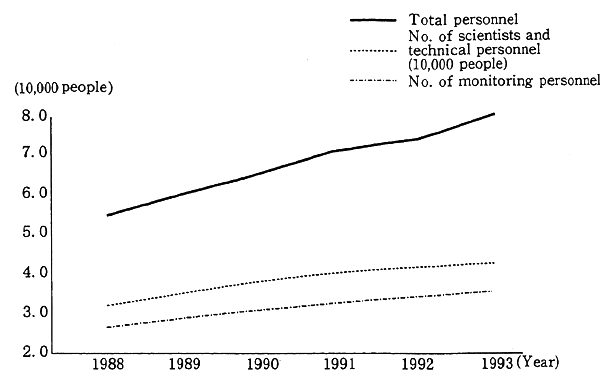
Reference: 1993 Report on the State of China's Environment
In addition, China adopted the 20-chapter, 78-article "China Agenda 21" (white paper concerning China's population, environment, and growth in the 21st century) in March 1994. The China Agenda 21 clarifies the strategies and policies China's sustainable development, and in Chapter 2, Strategies and Important Behavior for Sustainable Growth, it recognizes that "although China has entered a stage of history with rapid economic growth, the economic foundation is weak and technological standards are low, resulting in huge natural resource consumption volumes, and serious pollution. In addition, a weak ecologi-cal foundation has engendered and intensified all sorts of contradic-tions." Therefore, "judging from the basic characteristics of China's economy and society and from the restraints on the natural resource environment, unless the rational use of resources and protection of the ecological environment can be incorporated into the framework for economic growth, it will be impossible to sustain economic growth and difficult to leave the conditions for sustainable growth to following generations." Moreover, "under China's current growth strategies, policies, plans, and management mechanisms, it will be difficult to respond to the demands for sustainable development. By adopting comprehensive strategies for growth, targets and important actions Which adequately reflect concepts of sustainable growth, harmonious growth of population, the economy, society, the ecological system, and the environment should be achieved," positioning the direction of efforts to take toward future environmental problems, thus progress in environ-mental administration is expected.
(2) Republic of Korea (ROK)
The ROK government situation is said to have difficulty in nurturing local autonomy because of the strong central government authority, and like Thailand and Indonesia, environmental administra-tion has tended to involve pollution prevention measures taken by the central government while the local governments have not been very enthusiastic about pollution prevention. In recent years, however, great changes have been seen in the ROK government's environmental admin-istration system.
In the Republic of Korea, a Pollution Control Section was estab-lished in 1973 inside the Sanitation Bureau of the Ministry of Health and Social Affairs. It was upgraded to the Environmental Management Bureau in 1977, and in 1980 to the Environmental Affairs Bureau with jurisdiction over environmental administration as an outside bureau attached to the Ministry of Health and Social Affairs, and finally to an independent organization in 1990 with the elevation of the Environmen-tal Affairs Bureau to the Environment Agency, with the director gen-eral of the Environment Agency being a state minister. Then, in the course of a reorganization in December 1994, the Environment Agency was elevated to the Ministry of Environment. Its priority policies are drought countermeasures, water supply management, and appropriate disposal of wastes. In the field of air quality, it is engaged in exhaust gas regulations for diesel vehicles, supply of LNG and low-sulfur oil, etc., and ozone warning system, while for the conservation of ecological system it is promoting natural environment conservation projects. And as can he seen by such water supply management as the adoption of the Drinking Water Management Act in December 1994, reforms in the environmental conservation of water quality, the development of water supply environmental facilities, and the weight standard reclamation fee system for wastes, the previous dual emphasis on prior prevention and post-occurrence management has been shifted toward an expanded emphasis on prior prevention and expanded applicability of the Polluter-Pays-Principle.
(3) Indonesia
In Indonesia, the State Minister responsible for population and the environment was the one who conducted planning and proposals for environment-related policies and made the coordination needed for policies implemented by the various relevant ministries and agencies. Realizing individual policies related to environmental problems first became possible after adjustments were made to the organization having authority to implement the particular project, and implementa-tion of specific policies was in principle implemented by each of the relevant ministries or agencies. But recognizing that this system would not be able to respond comprehensively and dynamically to the environ-mental problems that can be expected to become more serious in the future, the government established the Environmental Management Agency in June 1990 as an organ under the direct control of the presi-dent. In April 1993, a new state minister responsible for the environment was appointed for proposing policies related to environmental problems, while the Environmental Management Agency continued to implement environmental conservation policies and to conduct environmental monitoring, etc.
Indonesia's development planning and coordination of environ-mental conservation are conducted by the Natural Resource and Envi-ronment Bureau, a part of the State Development and Planning Agency that has authority to make coordination to development plans and to allocate development budgets. In addition, the General Regional Devel-opment Bureau of the Ministry of Interior has within it an Environment and Developmental Structure Bureau that conducts coordination with local governments engaged in regional development, and also each of the relevant ministries and agencies independently implements the environmental policies. Local environmental administration is conduct-ed by provincial governors or local organizations of the relevant ministries and agencies, which generally function as local organs of the central government, and the local governments do not necessarily always play a leading role.
Indonesia commenced a second 25-year Long-Term Development Plan in 1994, and the first stage of that plan, the 6th Five-Year Develop-ment Plan (FY1994-98) has already started. That plan includes imple-mentation of policies and measures that particularly concern environ-mental conservation. Barriers to the implementation of environmental conservation measures in Indonesia that have been pointed out include the limited nature of government programs related to natural resources and environmental management, the lack of laws and regulations for natural resources and environmental management, and the shortage of environmental experts with knowledge of environmental sciences and technologies.
(4) Thailand
In the 7th State Economic and Social Development Plan launched in October 1991, the Thai government set development goals for sus-tainable economic growth and a fair allocation of incomes, and also for environmental conservation. This was the first plan where environmen-tal conservation had been positioned as a goal in a state development plan, and the New Environmental Conservation Law was promulgated in April 1992 as one part of this plan. In addition, the Ministry of Science, Technology and Energy was renamed as the Ministry of Science, Technology and the Environment, and the Environment Agency that had hitherto been responsible for environmental administration was replaced by three bureaus under the Ministry of Science, Technol-ogy and the Environment, called the Environmental Planning Bureau, the Pollution Control Bureau, and the Environmental Conservation Promotion Bureau. The Environmental Planning Bureau has regional environmental offices established in the eastern, northeastern, southern, and northern parts of the country to deal with regional environmental conservation measures. At Thailand's prefectural and county levels, however, there are generally no departments that specialize in environ-mental administration, nor, with the exception of such large cities as Bangkok and Chiangmai, are there any environmental administration organizations in existence in the autonomous cities and towns or in the sanitation districts.
Thailand's New Environmental Conservation Law strengthens organizations and regulations and includes the adoption of environmen-tal management plans and establishment of an environmental fund. In Thailand's environmental management, it has been noted that failure to make coordination among the policies of the many different ministries and agencies responsible for environmental administration has resulted in overlapping and contradictory policies concerning society and the economy, natural resources, and environmental protection. In addition, a shortage of awareness on the part of private-sector corporations toward environmental protection and pollution prevention, delay in the implementation of governmental policies, unified determination of envi-ronmental administration by the central government, and a shortage of personnel both in the public and private sectors who are capable of taking charge of the environment are some of the major problems that the country faces.
As can be seen from the examples of Thailand and Indonesia, environmental administration in developing countries in Asia is gener-ally an environmental administrative organization centering on pollu-tion prevention and is located in the central government. At the regional level, local organs of the central government, positioned in wide-area administrative zones or provinces, enforce environment-related laws and regulations and engage in environmental monitoring, etc., and also the relevant ministries and agencies conduct environmental manage-ment and environmental regulations directly.
According to the survey conducted in 1994 by the East-West Center, an international joint research institution located in Hawaii, out of more than 60 national, regional, and provincial environmental admin-istrative organizations surveyed in the Asia-Pacific region, the number of personnel in each country's environment agency varied widely, averaging about 10 people in the Pacific island nations, about 170 people in five Asian nations that included the Philippines and Thailand, about 800 people in the NIE countries and regions of Hong Kong, Singapore, and Taiwan, and about 3,000 people in industrialized countries including Japan. The small-scale environmental admisistrative organs were often actually run by bureau or section chiefs even if they officially had a prime minister or cabinet member as their top official, they tended to have a low priority in national administration when compared with other administrative areas. In addition, environmental administration in all the countries surveyed was often conducted as a joint activity administered by a large number of ministries and agencies that included specialized environmental administrative organs. Coordination and lin-kage with other related administrative organs are therefore very impor-tant. While the situation in every country is different, a number of environmental administrative organs surveyed noted that environmen-tal administrative organs are not always given sufficient authority.
The Basic Environment Plan offers support for the self-help efforts of developing countries to ensure both the environment and development and is actively promoting international cooperation for various kinds of environmental conservation. The capacity building in the Asia-Pacific region in environmental field has become a very impor-tant task.
2. Japan's Environmental Cooperation in the Asia-Pacific Region
Preservation of the environment in developing countries, and particularly in the Asia-Pacific region, is an issue involving all mankind in which Japan should be engaging in jointly with the countries of the region. Furthermore, it is important to promote broad international cooperation with the countries of the world, international institutions, etc., based on a global perspective for a wide range of problems that include population, resources, development and the environment.
The questionnaire for environment monitors "On Support for Developing Countries in the Environmental Field," conducted by the Environment Agency in FY1993, asked what environment monitors believed to be the problem most needing urgent action among the environmental problems developing countries facing, and the most common response was the decline in tropical rainforests (74.5%), foll-owed by serious air pollution and water pollution (65.6%) and the extinction or threat of extinction of wildlife (43.2%) (Figure 2-3-2). In addition, when asked what the Japanese Government should be doing to help improve the environment of developing countries, the respondents called for transfer of environmental conservation technologies (64.9%), assistance for NGOs and volunteer activities dealing with environmen-tal conservation (51.3%), capital assistance for projects useful for envi-ronmental conservation (39.8%), training in Japan for technicians and administrative officials from developing countries (3&1%), dispatch of personnel to international institutions (37.8%), take a leading role in international treaties negotiation (33.0%), and so on.
As can be seen, the people of Japan have great expectation for Japan's future international activities, and are demanding that Japan's skills be used to fulfill positive roles. To do this, Japan will need to assure international policy link-ups concerning global environmental conservation and will need to promote cooperation on the regional environment of developing countries. Japan will also need to develop a domestic foundation for smooth implementation of this kind of interna-tional cooperation, to assure international alliances for research and monitoring etc., to promote activities by local governments and private sector groups, etc., and to strive to take the environment into account when implementing international cooperation.
Fig. 2-3-2 Environmental Problems in Developing Countries
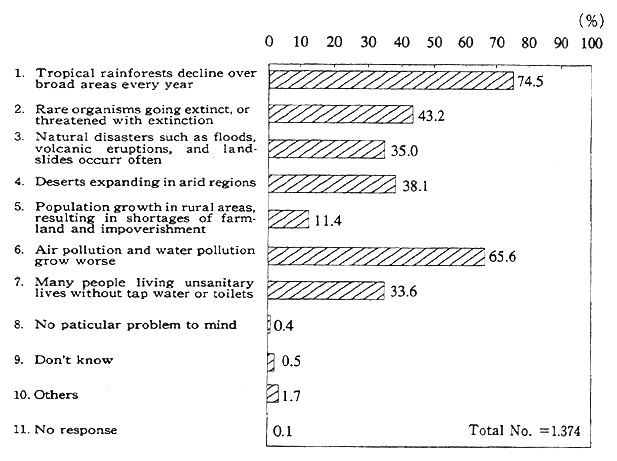
Reference: Environment Agency
(1) Japan's ODA in the field of environment
The concept of "sustainable development," which was first articulated in the 1987 report "Our Common Future" issued by the World Commission on Environment and Development, is based on the idea that the environment and development have an indivisible relation-ship, that development is based on the foundation of environment and resources, and that conservation of the environment is absolutely essen-tial for attaining sustainable development. Even in developing countries where development is needed for improving the lives of the people, development alone could damage the environment that is the basis of growth for future generations, or to put it another way, it means an awareness that preservation of the environment not only supports the survival of today's generation but is also necessary for supporting the survival of future generations in perpetuity.
Sustainable development is achieved by conducting projects that directly target environmental conservation and by implementing devel-opment projects in general in such a way as to avoid damaging the environment. Development assistance can take the form of preparation of laws and regulations for environmental conservation, creation of administrative organizations, training of administrators and techni-cians, creation of environmental monitoring systems, adoption of land use plans, development of nature preserves and national parks, develop-ment of water and sewer systems, development of pollution prevention facilities, creation of waste disposal systems, prevention of soil erosion, tree planting, and assistance for the activities which aim directly at environmental conservation. Moreover, preliminary checks are made when providing assistance for various kinds of development to ensure that the assistance will not damage the environment, and that counter-measures are taken when necessary. A look of Japan's development assistance toward the goal of sustainable development follows.
The concept of official development assistance (ODA) by Japan aimed directly at environmental conservation, the so-called environmen-tal ODA, was first clearly expressed at the Arche Summit of 1989. Here, the Government presented priority areas for environmental ODA, and revealed intentions to expand and strengthen the bilateral and multilat-eral environmental ODA funding, with a goal of 300 billion yen for the three-year period from 1989. This goal was more than achieved by the provision of 407.5 billion yen during the three-year period. Furthermore, at the United Nations Conference on Environment and Development (UNCED) held in June 1992, Japan announced a goal for environmental ODA that greatly expands and strengthens its bilateral and multilateral ODA from 900 billion yen to one trillion yen for the five-year period beginning in 1992. The follow-up to that announcement was a total disbursement of 508.3 billion yen for FY1992 and FY1993, to reach more than half of the targeted funding. Meanwhile, Japan's ODA (on a pure expenditure base, and including aid for Eastern Europe) in 1993 was 1,275.6 billion yen, of which bilateral ODA was 907.7 billion yen. About 540 billion yen of that bilateral ODA, equivalent to 59.5% of the total, was oriented to the Asian region, and that amount included aid for the region's environmental sector.
The ODA Charter decided by the Cabinet on 30 June 1992 posi-tions in its basic philosophy on protection of the environment as an issue involving all mankind that the developed and developing countries should be working together for, and promises to use assistance for the self-help efforts of developing countries to promote sustainable develop-ment on a global scale. In addition, the Basic Environment Law stipu-lates in Chapter 2, Section 6, that the Government should strive to adopt measures necessary for the promotion of international cooperation concerning global environmental conservation while the Basic Environ-ment Plan calls for Japan to provide assistance for the self-help efforts of developing countries that supports both the environment and develop-ment, and for actively performing various international cooperation activities for environmental conservation.
Based on this policy of strengthening international cooperation, Japan is actively promoting assistance to developing countries through ODA that concerns human settlement, forest conservation, pollution prevention, natural disaster prevention and natural environment conser-vation (Table 2-3-3). Specifically, this includes technical cooperation through dispatch of experts, acceptance of trainees, development sur-veys for the creation of regional pollution control plans, etc., capital assistance such as grant aid and soft loan assistance and outlays for international organizations.
In addition, Japan places emphasis on improving the ability of developing countries to deal with environmental problems, and has used grant aid to establish environmental centers in Thailand, Indonesia and China for concentrated research, training and monitoring activities, while at the same time conducting project-type technical cooperation that combines acceptance of trainees with dispatch of experts. Further-more, for the promotion of ODA in the environmental sector, Japan dispatches environmental missions and other kinds of survey teams to strengthen policy dialogues with developing countries and to formulate the project proposal.
The basic philosophy and principles of the ODA Charter, as well as the report issued by the Council of Ministers for Global Environment Conservation held in June 1989, called for strengthening environmental consideration in the implementation of official development assistance. Of the organizations actually involved in dispensing assistance funds, the Overseas Economic Cooperation Fund (OECF), which is responsible for yen-based loans, issued "OECF Guidelines for Environmental Consid-erations" in October 1989 in which it called for taking such environmen-tal considerations as checking to see whether the funding recipient had taken adequate environmental considerations. In addition, the Japan International Cooperation Agency (JICA), which is responsible for tech-nical cooperation, has adopted environmental consideration guidelines for each of its sectors of activity, beginning with the "Guidelines for Environmental Impact Surveys on Dam Construction Plans" issued in February 1990, and uses its preliminary surveys to check on the environ-mental impact. At the same time, every organization is improving its organization with respect to the environment, and taking steps to have environmental experts participate in survey teams.
The Basic Environment Law, taking the view that strengthening of these kinds of environmental considerations is important, stipulates in Article 35, Paragraph 1, that the nation in implementing international cooperation should strive to take global environmental protection into consideration for regional implementation of international cooperation. At the same time, the Basic Environment Plan also calls for precise operation of guidelines for environmental considerations in the course of implementing international cooperation, and calls for strengthening the basis for implementation of environmental considerations including development of human resources, etc., and for implementing appropri-ate and effective environmental considerations in alliance with interna-tional institutions, etc.
Table 2-3-3 Cooperation Performance in the Field of Environment in the Form of Either Bilateral or Multilateral Aid
1. Performance by form of aid
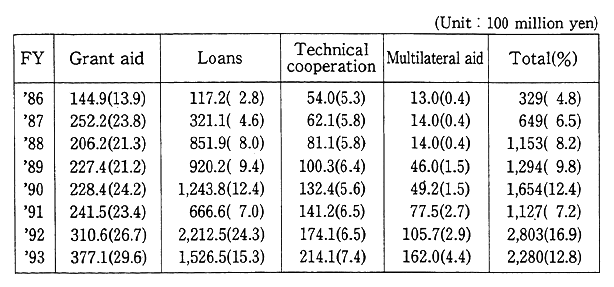
Notes: 1. Figures in parentheses for every column except the column "Total" are ratios (%) for each form of aid to total ODA. For grant aid, however, the figures are the ratio occupied by total regular grant aid (excepting emergency loans, non-project grant aid for economic structural reform), and grassroots grant aid). For loans, the figures are the ratio occupied by project loans and non-project loans (commercial loans, structural adjust-ment funding, etc).
2. Figures in parentheses in the column "Total" represent the ratio to Japan's total ODA.
3. Grant aid and loans are on an exchange official documents base, technical cooperation is on a JICA cost performance base, multilateral aid is contribution to international institutions on budget base.
2. Performance of bilateral aid by sector
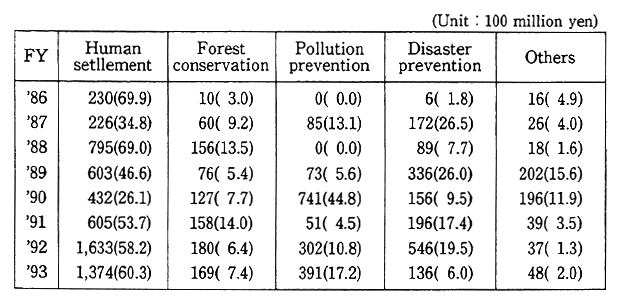
Notes: 1. Figures in parentheses are ratio to environmental ODA for that same fiscal year.
2. "Others" includes natural environment, environmental administration, marine pollution, etc.
Reference : Economic Cooperation Bureau, Ministry of Foreign Affairs : Japan's ODA (1991-1994)
(2) Efforts for environmental conservation in the Asia-Pacific region
In promoting environmental conservation in the Asia-Pacific region, it is necessary for Japan to promote broad cooperation between the countries and international institutions within the region, and to play a leading role in various fora for discussion, and to form environ-mental policy links in the region. The following outlines the related policies being undertaken in the Asia-Pacific region.
The Asia-Pacific Environment Conference (Eco Asia) was hosted by the Environment Agency in 1991, 1993, and again in June 1994 for the purpose of discussing the roles and issues of the Asia-Pacific region in realizing sustainable development, and for deepening the shared under-standing of methods for new cooperation in the future. The conference saw the participation of government officials, including the environment ministers in the Asia-Pacific region, representatives of international organizations, representatives of private-sector groups, academics, and others, and its results are expected to be of assistance to governments in the region and to related institutions in promoting efforts for long-term environmental conservation.
Concerning environmental cooperation in the Northeast Asian region, the Northeast Asian Conference on Environmental Cooperation has been held annually since 1992. After the first conference in Niigata and the second conference in Seoul, the Environment Agency hosted jointly with Hyogo Prefectural Government the third Northeast Asian Conference on Environmental Cooperation in September 1994 at Kinosa-ki Town in Hyogo Prefecture, with the participation of China, Russia, Mongolia, and South Korea. The third conference included a follow-up to CSD, and active exchanges of opinion on such themes as sustainable cities and biological diversity, and achieved agreement on strengthening cooperation in each field.
For environmental cooperation in the ESCAP region, while the South Asia, ASEAN, and South Pacific regions drew up regional envi-ronmental programs in quick succession around the year 1980, no such regional efforts were seen in the Northeast Asian region until recent years, and creation of a similar type of program has been awaited. The Senior Officials Meeting on Environmental Cooperation in Northeast Asia was held in February 1993, and was followed up by a second conference in November 1994. These conferences are expected to become important cooperative framework for trans-border pollution and for global environmental problems where regional cooperation is essential, and the exchanges of opinion should be. of help in obtaining a unified international understanding of environmental problems. In addition, ESCAP convenes a Ministerial-level Conference on Environ-ment and Development in Asia and the Pacific once every five years, and the next one is scheduled for November 1995.
In addition, to support the smooth implementation of the Frame-work Convention on Climate Change in the Asia-Pacific region, the 4th Asia-Pacific Regional Seminar on Global Warming was held in Bang-kok in March 1995 hosted by the Environment Agency and the ESCAP, and convened with the cooperation of the United Nations Environment Program (UNEP), etc. The seminar was held in Nagoya City in January 1991, in Bangkok in March 1993, and in Osaka City in March 1994. At the fourth seminar, discussions focused on (i) the state of progress in international efforts concerning the problem of climate change, (ii) the state of efforts in each country, and (iii) regional cooperation in the Asia-Pacific region for global warming policies.
The Vienna Convention and the Montreal Protocol were adopted under the initiative of UNEP, and countries are now making efforts based on these treaties to reduce emission of ozone-destroying sub-stances. Japan and other advanced nations are being asked to make international contributions in the provision of technology and funding, and in collection and dissemination of scientific knowledge. Japan has held the ozone layer protection seminars in FY1991 in China and Thailand, and in FY1993 in South Korea and Indonesia, for the purpose of assisting in the smooth promotion of policies for protecting the ozone layer through presenting papers and exchanging opinions and informa-tion by academic experts and others in various fields related to protec-tion of the ozone layer.
In the Asia-Pacific region, Japan is taking responsibility under the Japan-U.S. Global Partnership Action Program of January 1992 to promote the building of the Asia-Pacific Network for Global Change Research (APN), a framework for research cooperation in the region. APN builds governmental level cooperative system for the purpose of promoting global environmental research in all countries, including developing countries, and for boosting the countries' abilities to deal with global environmental problems. Japan is currently host to the network's temporary secretariat. The third Workshop for APN held in March 1995 ratified a joint statement summarizing discussions on the scientific themes targeted by APN, and on organizational and proce-dural matters, and announced that APN had entered into implementa-tion stage.
On conservation of the marine environment, the UNEP has been urging the countries that share international enclosed waters to take joint action to conserve the marine environment in those seas and the coastal waters. Twelve Regional Seas Programs have been adopted to date since 1975. Creation of a Northwest Pacific Regional Seas Program centering on the Sea of Japan and adjacent seas was under study since 1991, and an action plan was adopted in September 1994 by China, Japan, South Korea and Russia.
An acid deposition monitoring network is important as a first step in regional joint efforts to deal with the acid deposition problem in the East Asian region, and since cooperation within the region is necessary for realization of such a network, the Environment Agency is currently proposing the "East Asia Acid Deposition Monitoring Net-work Concept." Because countermeasures should be implemented and necessary international cooperation should be promoted based on shar-ing of measurement data and information among various countries in the region and on a common awareness of the acid deposition problem, the agency, with the cooperation of the relevant institutions, convened expert meetings over a period of three years from FY1993 to FY1995, where exchanges of views and studies by experts from all East Asian nations and related international institutions are carried out, and is moving toward its goal of creating the East Asia Acid Deposition Monitoring Network.
Concerning the conservation of water birds and their wetland habitats, an East Asia-Australia Region Wetlands and Water Birds Workshop was held in Kushiro City in November 1994 with the partici-pation of experts and others from all countries along the migratory routes of water birds in the East Asia and Australia, for the purpose of studying how cooperation among the countries should be conducted in future, and what actions should be taken within each country, and of developing conservation strategies and action plans for wetlands and migratory birds. As a result of the meeting, a statement was released calling for the development of a network of sanctuaries along the migratory routes, and for development of an action plan for water birds protection.
Concerning industrial pollution, which threatens to become much more serious in the future in the Asia-Pacific region's developing coun-tries, Japan considers it very important to transfer and disseminate technology broadly based on its experiences in overcoming industrial pollution by utilizing knowledge possessed by the private sector. For example, under the Green Aid Plan, a system has developed so as to responde appropriately to various cooperation needs through environ-mental technical cooperation, intimate policy dialogues with developing countries, cooperation in human resource development and in research and surveys, and active use of experts in industries
(3) Environmental cooperation of local governments
While much of the environmental cooperation for dealing with the Asia-Pacific region's worsening environmental situation caused by rapid urbanization, industrialization, and population growth has carried out to date mainly by the national government, increasing requests from developing countries and diversified needs have led to requests for the cooperation of Japan's local governments, as well.
Kitakyushu City is actively promoting environmental cooperation with its sister-city of Dairen City, and is attracting attention as a working-level sister-city exchange that takes advantages of the city's special characteristics. In December 1993, Kitakyushu City proposed to the Chinese side that Dairen City be designated as a special environmen-tal protection district. The Chinese Government accepted that proposal in early 1994, and incorporated the idea into that year's State Environ-mental Protection Priority Projects. The construction plan for the Dairen Special Environmental District sets a goal to achieve the envi-ronmental condition of Kitakyushu City, and establishes projects to be completed in 10 to 15 years that include developing water and sewer lines and treatment facilities, relocating industrial plants, strengthening regulations, developing monitoring systems, and developing research and development systems, and the results of this plan are spreading throughout China and even to other nearby developing countries. In the future, Kitakyushu City plans to call on related institutions for coopera-tion, and to create a cooperative system including the Kitakyushu International Techno-Cooperative Association (KITA) and other inter-ested people, and to promote cooperation in alliance with industry, government, and academia.
In addition, Yokohama City is using international cooperative activities stemming from overseas technology exchange projects con-ducted jointly by private corporations and the city to promote efforts toward creation of a regional level network in the Asia-Pacific region and support for the International Tropical Timber Organization (ITTO). In 1982, the city hosted the "Regional Congress of Local Authorities for Development of Human Settlement in Asia and the Pacific." It also promotes the creation of inter-city exchange network activities, including active support for the "CITYNET" organization that distributes technical advice among cities in the Asia-Pacific region, and conducts training and observation, etc. In addition, the city gets involved in international cooperation by dispatching technical personnel in the environmental sector overseas, receiving visitors and trainees at its environmental monitoring center, offering funding support for groups engaged in international environmental conservation activities, and engaging in international environmental conservation volunteer registration systems.
Elsewhere, Hiroshima City and Chongqing City in the Sichuan Province of China are using a friendship relation to engage in environ-mental cooperation for pollution prevention and forest protection, while the four entities of Hiroshima Prefecture, Sichuan Province, Hiroshima City, and Chongqing City are joined together to promote efforts against acid rain. The forest protection project involves having Hiroshima Prefecture, the nation's largest importer of foreign lumber, make an international contribution by dispatching experts in afforestation tech-nology, accepting trainees, and having prefectural residents participate as volunteers in tree-planting activities. In addition, in the area of acid deposition research, the Acid Deposition Research Center has been established on the grounds of the Chongqing City Environmental' Research Institute to promote surveys and research into acid deposition.
As noted thus far, local governments need to take the lead in environmental cooperation, as bearers of sustainable societies based on an accumulation of individual activities at the regional level, and on a global partnership. Therefore, in order to promote international efforts aimed at environmental cooperation among local governments in Asia that is closest to Japan both geographically and culturally and local governments in Japan, the Environment Agency is conducting the Asia Region Local Government Environment Initiative Promotion Project. The five countries of China, India, Indonesia, the Philippines and Thailand are participating in the project, with three local governments from each country (15 local governments in all, including Suzhou and Mumbai), engaging in general surveys of the state of environmental problems and issues, and with local governments in Japan and those in the other countries and developig model environment improvement projects, so as to lead to development of specific methods for conducting environmental cooperation at the local government level.
(4) Efforts by corporations and private-sector groups
Japanese corporations are actively engaged in developing busi-ness activities overseas, and this is apparent in the Asia-Pacific region, as well. The environmental problems of Japanese corporations in the Asia-Pacific region have often been pointed out in the past, including the import of shrimp, lumber and ores, and exports of toxic wastes. In addition, environmental considerations are an important part of the environmental policies of corporations advancing overseas and for business activities in the Asia-Pacific region. As can be seen by the Global Environment Charter issued by the Keidanren (Japan Federation of Economic Organizations,) industry is independently moving to pro-mote efforts. Yet demand is rising for making efforts to give appropri-ate environmental considerations. In FY1994 the Environment Agency conducted a survey of environmental consideration activities by Japanese corporations operating in Thailand, Indonesia, Malaysia and the Philippines.
For environmental cooperation activities by Japanese corpora-tions in the Asia-Pacific region, corporations are engaged in such social contribution activities as tropical rainforest protection activities in Malaysia and the convening of conferences concerning protection of the ozone layer in Asia. In addition, since environmental investment is expected to grow as part of the environmental measures of countries in the Asia-Pacific region, Japanese corporations are engaged in the trans-for of environmental conservation technologies, including pollution prevention equipment and other.
For example, the U.S. Department of Commerce estimates that Taiwan's environmental market was 907 million dollars in 1991, of which imports accounted for about 68% (Table 2-3-4). India's market for pollution prevention equipment was US$400 million in 1990, of which imports accounted for 20%. In addition, China's expenditures related to water pollution amounted to about US$433 million in 1991, of which imports were US$50 million. Japan accounted for 40% of those imports, followed by Australia with 25% and the United States with 8%. Also, South Korea had corporate pollution prevention expenditures of US$732 million in 1991. But South Korea's Ministry of Energy and Resources asserts that air pollution regulations will be strengthened in 1995, while those for water pollution will be strengthened in 1996, thus the nation's domestic environmental investments will increase from US$1.25 billion in 1992 to US$4.5 billion in 2000. The economic activities of Japanese corporations engaged in this environmental market can be expected to become still more vibrant in the future, and they can be expected to be of help for environmental measures in the Asia-Pacific region's.
For the efforts being made by private-sector groups in the Asia-Pacific region, the Asia-Pacific NGO Environment Conference was held in Kyoto in November 1994 with participation of NGO representa-tives and researchers from the Asia-Pacific region, and they agreed to cooperate in the survey and research activities being conducted for environmental problems in each cou
ntry of the region.
Table 2-3-4 Market Scale and Trade Volume of Environmental Industries in Taiwan
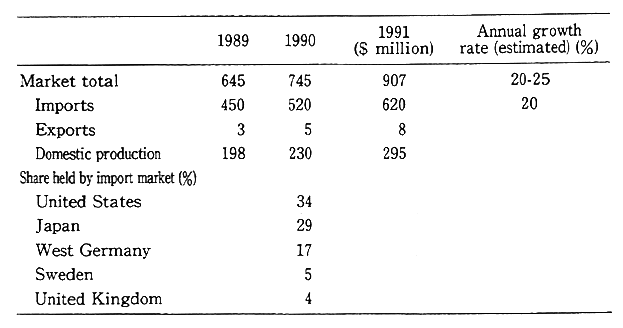
Source: U. S. Department of Commerce and American Institute in Taiwan
Private-sector groups play major roles in promoting cooperation with countries in the Asia-Pacific region. With enlightening people of the importance of international cooperation, many groups are engaged in the promotion of environmental cooperation. For environmental conservation activities in the Asia-Pacific region, about 295 million yen of the assistance provided in FY1994 by the Japan Fund for Global Environment was dispensed to 58 groups, accounting for 67.4% (about 68% of the support by value) of the total number of groups both inside and outside Japan which are engaged in environmental conservation activities in developing regions. They are mainly engaged in afforesta-tion, in conservation of the natural environment, in prevention of air pollution and water pollution, in environmental conservation of man-grove forests, in the convening of environmental conferences and semi-nars, and in enlightenment activities. In addition, they have gained the cooperation of local governments to provide used air pollution measur-ing equipment to China and garbage collection trucks to Vietnam, and have commenced activities that contribute to regional environmental conservation.
(5) Sustainable development in the Asia-Pacific region and Japan's role
The Asia-Pacific region is forecasted to develop the most vigor-ous economic activities in the world toward the 21st century, and these economic activities are raising the degree of mutual reliance among the nations of the region, and still greater flows of people and materials within the region are expected. Meanwhile, industrialization and rising living standards are causing rapid increases in energy consumption, leading to increased emission volumes for sulfur oxides, nitrogen oxides and other air pollutants, and for carbon dioxide and other greenhouse gases, while water pollution, toxic waste pollution, and other environ-mental problems are threatening to become worse. At the same time, forests, soil, fresh water resources, biological diversity, and other parts of the natural environment are threatened with degradation, and the effects of this worsening environment are found not just in a nation or a region but are threatening to spread across the global environment as a whole.
The most important viewpoint to take in response to these environmental problems in the Asia-Pacific region is sustainable devel-opment. The Asia-Pacific region is in an extremely important period for achieving sustainable development, and efforts taken for environmental problems in the region can be considered as touchstone for determining whether the concept of sustainable development is actually achievable. ESCAP is engaged in building a framework for cooperation within the region based on its "Regional Strategy toward Environmentally-sound and Sustainable Development in Asia and the Pacific" which was adopted in 1991, and through deliberation at its Committee on Environ-ment and Sustainable Development. At the same time, the forum for Asia Pacific Economic Cooperation (APEC) convened a meeting of environment ministers in March 1994, at which time the intimate rela-tionship between environmental protection and economic growth toward realization of sustainable development in the region was reaffir-med. Hereafter, consideration will be given to the viewpoints important for promoting sustainable development that takes advantage of the special characteristics of the Asia-Pacific region, as well as to Japan's role.
In the countries of the Asia-Pacific region, the cities are experien-cing ever more serious water pollution due to domestic waste water and air pollution due to automobile exhaust gases while at the same time being beset by industrial pollution. In addition, the rural districts are suffering from such environmental problems as the disappearance of forests and loss of soil. Furthermore, the countries have in recent years been confronted with such global environmental problems as global warming and the depletion of the ozone layer. It is important to fully recognize the diversity of environmental problems found in the coun-tries of the Asia-Pacific region, and to promote specific cooperation for each of these problems, and to promote cooperation for integrated, all-encompassing measures that take global environmental problems into consideration.
In addition, when considering the Asia-Pacific region's environ-mental problems, they should be thought of as integrated problems backed by growing population, poverty, urbanization, industrialization, etc., and even when considering conservation of the natural environ-ment, an approach should be taken from the viewpoint of living stability for local residents and appropriate management of the natural environ-mental foundation. In environmental cooperation, it is important that the true environmental needs of each country be accurately grasped, that studies be made of the appropriate technologies for each country' s stage of development, and that cooperation responsive to these issues be promoted.
The countries of the Asia-Pacific region are in various stages of economic development and industrial structure, and while mutual depen-dence is deepening in every area, it is still rational to allocate appropri-ate responsibility for the various burdens on the environment that accompany these economic activities, in accordance with the stage of economic development, the industrial structure and the natural environ-ment. In particular, efforts to cope with environmental problems that go beyond national boundaries such as acid deposition or marine pollution, or in the prevention of environmental destruction in developing coun-tries, cooperation within the region for the environment and develop-ment is important for establishing sustainability in the region.
Meanwhile, the steady promotion of environmental administra-tion in the countries of the Asia-Pacific region requires integration with other government policies, such as, integration with economic policy, consideration of the environment in transport policy and environmental education for human resource development. Economic development should reflect the idea of sustainable development, and environmental considerations should be incorporated via the application of environ-mental impact assessment and the Polluter-Pays-Principle into the government's basic idea concerning economic growth. By cooperation between the development bureaus and environment bureaus in the countries of the Asia-Pacific region, it is necessary to guide policy development and planning and implementation of projects in various directions that can maintain sustainability. Japan should be striving to grasp the organizational and human resource situations that are best suited to each country, and should be strengthening various methods for improving the capability of these human resources.
As seen in the annual reports on environment up to last fiscal year, corporations in high economic growth periods can aggressively invest in plant and equipment and new technologies. This means that corporations in the countries of the Asia-Pacific region should also engage in aggressive environmental investment, should promote the introduction of environmental technologies, and should seek to establish both economic growth and environmental conservation in the region overall. This is the basis for sustainable development. The transfer of Japan's environmental technologies should not involve merely the export of environmental technologies, but should contribute to develop-ment of industry and of eco-businesses in each country. At the same time, it can be anticipated that Japanese corporations will actively engage in regional cooperation and technical cooperation in the environ-mental field.
Japan's local governments have accumulated much on-site experi-ence in the environmental field, and also have many experienced people. An environment should be created that makes it easy for these human resources to actively participate internationally. In addition, merely mobilizing the human resources of local governments is not enough. It is also important for the local governments for themselves to promote environmental cooperation at the local level through networks forged with sister-cities and friendship-cities, and to then take knowledge so obtained and bring it as input for cooperation at the national level.
Private sector groups in both assisting countries and recipient countries play a major role in promoting more detailed assistance and environmental cooperation. Private sector group networks should be utilized to ensure adequate communication with local residents and NGOs and to conduct projects that contribute to the local areas.
In order to deal with today's wide-ranging environmental prob-lems, and to attain sustainable development on a worldwide scale, a proposal was made for the necessity of an institution open to the world where comprehensive research is conducted on a strategy for confront-ing global environmental problems with cultural and social sciences viewpoints as well as the natural sciences, having within its view of cooperation for developing countries, and where proposals aimed at both home and abroad can be made.
In addition, with the APEC summit meeting to be held in Osaka in November 1995, APEC that was originally characterized as a forum limited to economic issues now incorporates environmental considera-tions through its various working groups (WG), and serious studies of environmental problems are now being undertaken based on the conclu-sions reached at last year's meeting of environmental experts. While the main issue for APEC is the future liberalization of trade and investment, environmental considerations in the Asia-Pacific region can now expect to be promoted, along with Japan's active participation, when dealing with these economic policies.
Efforts that take the long-term view spanning across future generations are required if sustainable growth is to be achieved in the Asia-Pacific region, and precise information will be the foundation for policy proposals concerning the future outlook for the environment and development. Currently, the Environment Agency's Asia-Pacific Envi-ronment Conference (Eco Asia) is to commence a project forecasting the long-term outlook for the Asia-Pacific region in 2025 with the participa-tion of experts from related countries and institutions. It is believed that this future outlook projection will contribute to the formation of a common recognition among officials in charge of policy development within the region, and should also help to smoothly promote regional cooperation.
It has been shown that there are many issues that need to be dealt with in the course of moving toward sustainable growth for the Asia-Pacific region. Since the Asia-Pacific region can be expected to exhibit ever deeper relationships of mutual dependence in the future, still more promotion of regional cooperation will be required in the environmental field, as will the mechanisms for that purpose. It is hoped that at the Environment Agency's Asia-Pacific Environment Conference (Eco Asia) continuous efforts will be made to contribute to cultivation of a com-mon understanding and formation of partnership in various national and regional policy development, and of the efforts needed for common environmental problems. This is the kind of effort that could well become a model for other regions in the world, and at the very least for the developing regions, and Japan needs to be demonstrating initiative in the promotion of environmental cooperation in the Asia-Pacific region.
Chapter3. Japan's Environmental Stock as Viewed from the Next Generation
Passing on a healthy, rich, and prosperous environment, the foundation of human survival, to future generations is a major responsi-bility for those of us living today. We should view Japan's environment today as a stock, correctly recognize what its conditions are and the direction of any changes, and think about what kind of environmental stock we will be able to pass on to future generations. While we shall do an overview of the state of Japan's environment in Chapter 5, in this chapter, we shall scan the current state of the environmental stock with particular focus on the three points that deserve the most notice, and shall look at what shape this environmental stock will be in when future generations receive it from us.
The first point is "soil." Along with air and water, soil is one of the major components of the environment, and is also an important factor supporting the natural material cycle. Here, we shall make appropriate evaluations of the environmental protection functions that soil possesses, and look at the state of the environmental load, the state of the materials cycle, and the state of the environment as it pertains to soil, including the multifaceted relationship between people and soil, and then examine the importance of soil that should be passed on to the next generation.
The second point is the state of the natural environment in high human impact areas and in countryside areas. These areas are places where people are deeply involved with nature, they being where many people live, where such industries as farming and forestry exist, and also where nature is in retreat in the face of urbanization. Moreover, we believe that the natural environments of these areas will grow even more in importance in the future as places where people can come in contact with nature. We shall focus here on these areas, and shall examine the current state of Japan's natural environment, the natural environment that should be passed on to the next generation, and ways to coexist with these areas.
The third point is the effects that global warming will bring on Japan's environment. Global warming is one of the most worrisome of global environmental problems, and if global warming is allowed to progress unchecked, it is expected to engender great changes in the future environment of the world, including Japan's. Here, we shall take a general look at how global warming caused by increased amounts of greenhouse gases in the atmosphere will affect Japan's environmental stock of water and nature, and shall think about how to deal with global warming and what kind of environment we should leave to future generations.
Section1. Japan's Environment as Viewed in Soil
As the term implies, the soil covering the Earth's upper crust leads a plain existence when compared with water or air. Yet it is the foundation of life for people and other living things, and also plays an essential role in the cycling and maintenance of materials.
In this section, we shall examine the role that soil plays along with water and air as an important component of the environment, all the while keeping in mind the relationship with the lives of people today.
1. The Formation of Soil and Special Characteristics of Japan's Soil
(1) The formation of soil
Soil consists of humus that is formed by organisms in the soil decomposing and reconstituting minerals, and the remains and excreta of plants and animals, and of many soil organisms nurtured within the soil.
Let's look at how soil is formed. First, lichens and mosses grow on top of stones and rocks. These use photosynthesis based on solar energy to assure themselves of the necessary energy to survive. When these plants die, their remains are broken down by microorganisms. The carbonic acids and organic acids generated in this process hastens the decomposition of the rock. Calcium, potassium, and other bases released in the decomposition then begin to serve as nourishment for other microorganisms or small plants. In the course of repeating this process many times, ever larger plants come to be nourished. A large amount of biomass congregates on the surface and the number of microorganisms and small plants increases. Organic materials generate humus. And in this way, soil slowly begins to form. Creation of soil takes geological amounts of time, and while there may be variances depending on conditions, it is said to be no more than 0.01 millimeter per year per unit of area. Soil can be called a valuable resource generated by the globe over many years of working.
Viewed on a global scale, soil is a repeated cycle of creation, effluence, conveyance, and accumulation (Fig. 3-1-2).
Fig. 3-1-1 From Rock to Soil
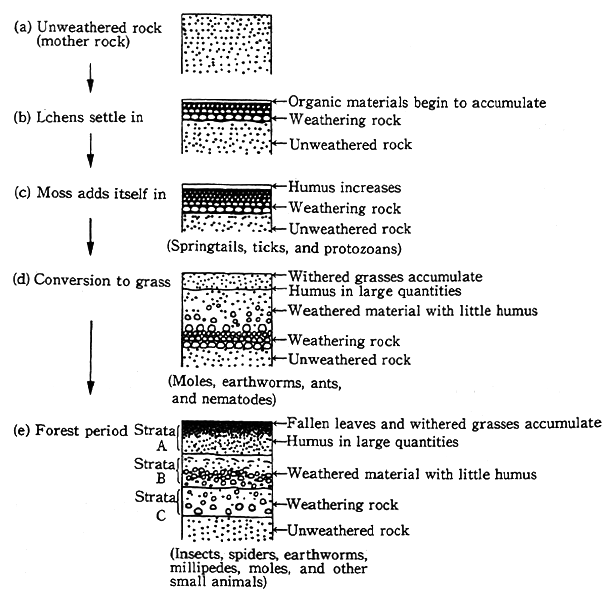
("Dictionary of Science, 3rd Edition", Iwanami Shoten (1985))
(2) Special characteristics of soil in Japan
Japan is an island nation with a humid climate, and with its many mountains, volcanoes, rapidly flowing rivers, it exhibits a soil composi-tion that is different from continental soils. Japan's soil possesses a tendency to become acidified because of the high rainfall. Nevertheless, let's make a summary look that divides the country broadly into western Japan, and eastern and northern Japan (Figure 3-1-3). Mountain-ous districts in both areas commonly have brown forest soils consisting of accumulations of still undecomposed leaves and other matter. Whereas the plateaus and hill districts in western Japan are commonly red or yellow clays and the soils are often fine-grained, regions from Kanto northward and also in Kyushu are often kuroboku soil derived from volcanic ash. In low-lying districts can be seen grey soil appearing in damp environments, brown lowland soil in well-drained areas, and tan-colored lowland soil found in areas somewhere in-between the aforementioned extremes and which is seen the most often.
Fig. 3-1-2
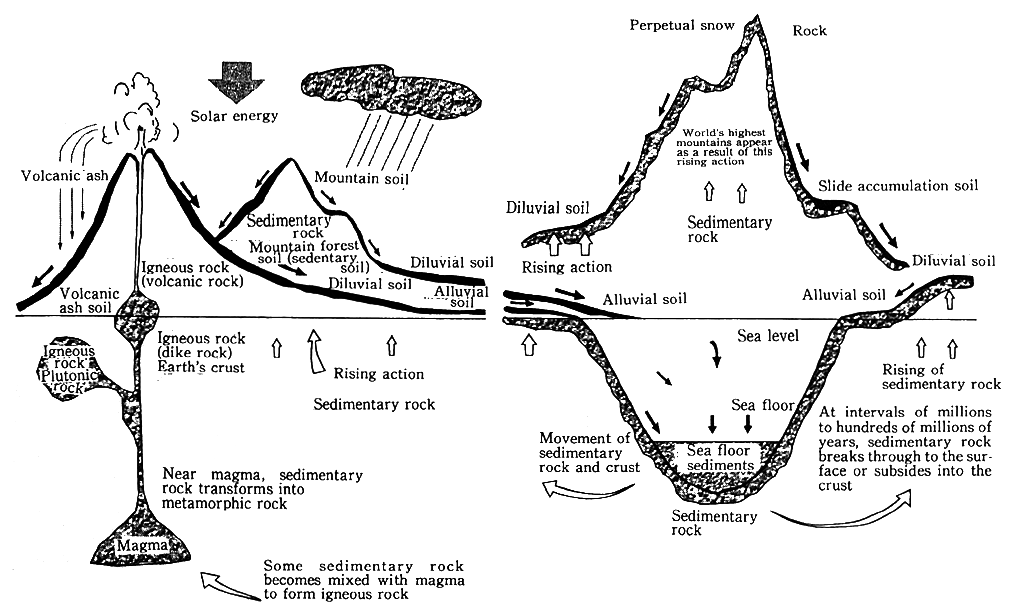
Source: Masao Maeda and Yoshiro Matsuo "Illustration: Basic Knowledge about Soil"
Fig. 3-1-3
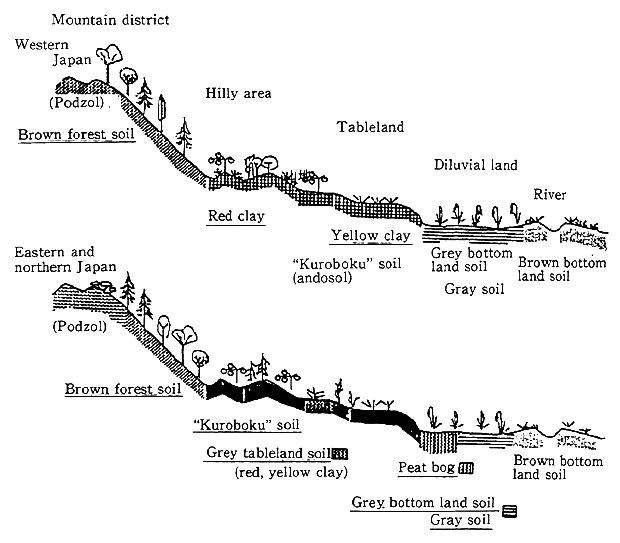
Source: "World of Soil" Editing Group, "World of Soil"
For farmland paddies, the harvest yield in Japan of wet rice per unit of paddy area is the highest in the world. Paddies begin collecting water in May and June, when the temperature is rising, and while the topsoil that comes into contact with the water remains oxidized because of algae and other organisms, a blue-tinted reduction layer also appears because the air and soil are cut off from each other. Winter, by contrast, exhibits an oxidized state, so that the soil repeatedly undergoes oxida-tion and reduction, which accelerates the rate of mineral breakdown and results in rapid aging of the soil. The soil is enriched, however, from the many kinds of nutrients drawn from irrigation water and from the accumulation of organic materials.
Also, whereas the paddies receive large amounts of naturally supplied nutrients through the irrigation water, Japan's dry fields get virtually none of this. Moreover, the terrain is often complex and strongly sloping. For this reason, soil erosion measures are probably necessary in upland farming villages where soil protection management is not adequately carried out.
2. Human Activities and Their Relation to the Soil
(1) Rich blessings from the soil
From the point of view of the environment, soil performs a variety of tasks. First of all, soil is necessary for all kinds of material and energy cycles. Plants generally support themselves by putting down roots into the soil, absorb water and nutrients from the soil, and use solar energy to assure themselves of the energy needed to survive. Animals either directly or indirectly make use of the energy produced by plants to obtain the energy for survival. Dead life forms and excreted waste products are returned to the soil where microorganisms break them down, preparing them to again be absorbed back up into the plants, in a massive cycle of life involving matter and energy.
Here, we would like to examine the blessings that we receive from the soil, from the point of view of 1) a precious resource that serves as the foundation for agriculture to produce food and as the raw material for all kinds of industrial products, and supports our lives, 2) a possessor of the tasks of storing water and supporting survival of life forms on the land, purifying water, and fostering underground water, 3) a possessor of the abilities to shape a variety of ecologies, to support microorganism survival, and to encourage decomposition and purifica-tion, and 4) a possessor of the task of stable maintenance of its own properties.
Fig. 3-1-4 Energy, Material Flow and Soil
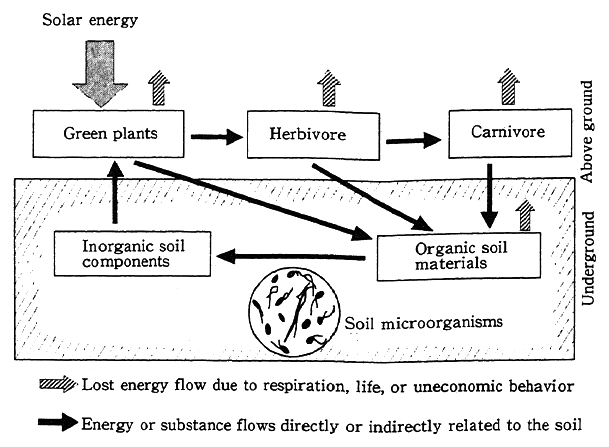
Source: Masao Maeda and Yoshiro Matsuo i; "Illustration: Basic Knowledge about Soil"
1) Soil as a resource supporting our lives
Soil possesses the aspect of being an extremely important and limited resource that is essential for our survival, as a resource for food production.
For example, soil possesses the capability to produce the grain, vegetables, and fruit that become our food, as well as the lumber that becomes materials for our furniture and houses.
While crop harvest volumes will vary depending on soil fertility, weather conditions, and cultivation methods, soil can play the role of storing water and nutrients needed for crops. As we have seen, water can be stored in cracks in the soil while nutrients can be stored in solid inorganic or organic matter. Nutrients undergo organic and chemical processes, are dissolved in water, and absorbed into the roots in the form of ions. The clays and humus inside the soil combine to form colloids. Because these colloids present a negative electrical charge on their surfaces, they retain within them positively charged ammonium ions, potassium ions, and calcium ions.
In addition, since crop roots support the aboveground portion, and absorb the nutrients and water, preserving healthy conditions for the roots is important for harvest volumes. The soil plays a big role in maintaining good conditions for the roots, such as an appropriate temperature and supply of the necessary oxygen for root absorption.
The soil also supports our lives by serving as raw material for a variety of industrial products. For example, clay is an essential material for pottery, cement, glass, tile, roof tiles, and other ceramics, and is also used as a medium for carrying pharmaceuticals and agricultural chemi-cals. Soil is also used as raw material for a variety of such well-known industrial products as paper, particularly the heavy-feel coated papers, and pencil leads, and so brings to us the blessings of life.
Table 3-1-1 Mined Clays and Their Uses
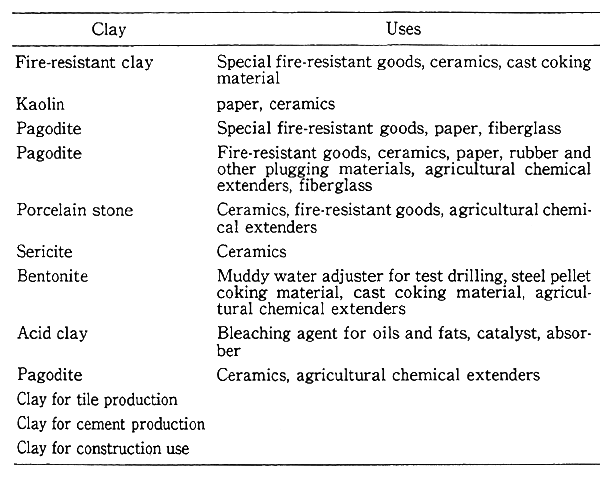
Source: Japan Clay Association, ed., "Clay Handbook, 2nd Ed."
2) Soil as a possessor of the tasks of purifying and storing water
Japan has a forest area of about 2.53 million square kilometers, which stores within it water about one centimeter deep, or in other words, 2.5 billion tons of water. The soil is riddled with cracks, and water flows into those cracks. Water movement is controlled by a capillary phenomenon that arises between soil particles and the water. The height that water can be pulled up is in inverse proportion to the radius, so that the narrower the cracks, the more that water can be absorbed upward and become strongly attached to soil particles.
This action allows all the life forms in the soil to live with water in the soil. Moreover, the plants that have extended their roots into the ground can absorb the small amounts of water in the soil and bring it upward to the trunk, branches, and leaves aboveground so that photo-synthesis can be used to convert solar energy into organic energy. In this way, a great number of life forms, including we humans, are awash in the blessings that come from the soil's ability to retain water.
An important point to remember here is that the properties of the topsoil can have a great influence on the water cycle. In soil on denuded mountains, topsoil riddled with cracks is eroded by rainfall, with the result that much of the rainfall does not seep into the ground but instead flows across the surface to cause flooding. Forest soils, by contrast, are rich in organic materials, and possess structures that are almost clump-ing, so that even in torrential rains approaching 100 millimeters an hour, the soil can absorb all the water into the ground, enriching the under-ground water with nutrients, and then steadily release the water into the rivers.
In the same way, dry fields possessing the clumped structures can, under careful management, retain vast amounts of rainfall seeping into the ground, and supply it steadily to plants. Poorly managed dry fields, however, where soil is not properly clumped, fail to retain the rainfall, resulting in drought-damaged crops.
The role played by paddies in Japan is big. Paddies are thought to have the capacity to temporarily store up to 200 millimeters of rainfall per hour. Japan's paddies bring a total of 45 billion cubic meters of water into the soil each year, of which nearly 10% is supplied to underground rivers. When we consider that the volume of residential water used in Japan in 1990 amounted to about 14.2 billion cubic meters annually on an effective water volume base, and that industrial water used also amounted to about 14.7 billion cubic meters, we can compre-hend just how vast the storage capacity of these paddies is. The paddies are playing an important role in maintaining a healthy water cycle in volume terms.
Soil possesses the task of purifying water. When organic material enters the soil, it is eventually broken down by the food chain of soil organisms into water and carbonate gases. And garbage, excreted wastes from life forms, and remains are physically filtered and separat-ed by the soil particles. Furthermore, ion exchange action helps the soil retain noxious metallic ions such as chrome or cadmium to purify the water in the soil.
If underground water is continuously utilized for long periods of time at rates higher than underground water sources are supplying water volume, the healthy underground water cycle could be damaged, leading to the occurrence of ground subsidence. In urban districts, road pavement and other obstructions can damage the flow of nutrients in underground water, so in the design of roads, walkways, and under-ground passageways it is important to consider how to appropriately steer rainfall back into the ground.
3) Soil from the viewpoint of ecology
i. Storehouse of genes
Large numbers of soil organisms survive in fertile topsoil. Specifi-cally, these include swarms of such soil organisms as plant roots, mammals, soil-based animals like earthworms, arthropods, nematodes, and other primitive animals, as well as bacteria, actinomyces, fungi, and algae. Soil plays a role as a storehouse of genes creating a rich ecology.
ii. Decomposition and purification functions
The biomass of all organisms in the soil per 10 acres, while it can vary according to region, can reach as much as several hundred kilo-grams. And the volume of soil that is affected by these organisms is said to reach 1,000 tons per hectare.
Organic material such as fallen leaves are finely ground down, ingested, and then excreted as wastes by earthworms, millipedes, wood louses, insect larva, and others. This excreta is further ingested by microorganisms and eventually converted into such nonorganic sub-stances as carbon dioxide, water, ammonia, and sulfates.
Plant material not yet converted into humus, and soil, is ingested by earthworms is emitted into fertile soil mixed with organic materials. This earthworm effect works as follows.
(1) By opening up crevices inside the soil, they create well-aerated and well-drained soil.
(2) Earthworm excreta is concentrated with calcium, moderating
Fig. 3-1-5 Animals Living in the Soil

Not with the same scale. a: Shelled amoeba, b : Amoeba, c : Bipaliidae, d: Planaria, e: Nematode, f: Tardigrada, g: Rotaria, li: Orobdella, i: Gulella (Sinoennea) iwakawa, j : Earthworm, k : Book scorpion, I: Spi-der, m-o : Mite, p : Gammaridea, q : Millipede r : Geophilomorpha, s : Campodeidae, t : Wood louse, u : Springtail v : Pselaphidae, w : Ant, x : Mole, y : Dipterous larvae, z : Gold beetle larvae (From Junichi Aoki)
Source : Shinya Tsuru, "The Soil Planet" soil acidification tendencies.
(3) Earthworm wastes are easy for microorganisms to consume, thus hastening the humus-forming process.
(4) They also emit viscous substances that facilitate soil clumping.
There is a range of observation results on the amount of soil decomposition by earthworms, such as, for example, reports of 2.3-6.1 kilograms decomposed per square meter over one year, or during a half-year rain period, 225 tons decomposed per hectare.
Microorganisms such as bacteria, actinomyces, and filamentous fungi have a high capabilities in oxidizing organic material, and because so many exist, they play large roles in the material cycle.
Table 3-1-2 Species, Size and Number of Soil Life Forms
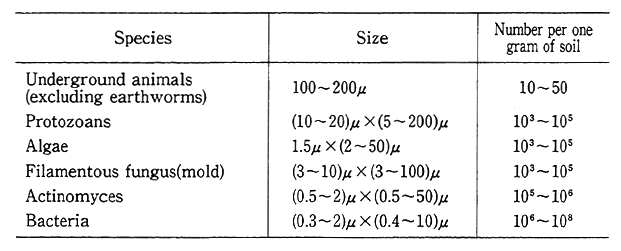
Note : Underground animals range from insect larvae to earthworms, and size therefore spans a broad range. (From Arao Itano, "Soil Microbiology", 1937, and Waksman, "Soil Microbiology", 1952)
These soil organisms decompose organic material, emit carbon dioxide, and secrete nonorganic nutrients required by plants, and the activities of these soil organisms maintain a fertile plant nurturing environment.
Next, let's dig into the soil organism cycle for carbon, nitrogen, and phosphorus.
iii. The soil organism cycle
(i) The CO2 cycle
First, let's look at the soil organism activities cycle for CO2. The CO2 released into the atmosphere by animal and plant respiration, or by various human industrial and residential activities is consumed by plants in photosynthesis. The carbon accumulated inside plants in this fashion is broken down by soil organisms working on the plants them-selves, or on the excreta or remains of the humans and animals that ingest the plants, and converted into humus, and eventually over long years is converted into such resources as coal, oil, or natural gas, or is released as CO2. The released CO2 is either emitted back above ground or accumulated in the soil as carbonates or bicarbonates.
(ii) The nitrogen cycle
Organic nitrogen in the soil is decomposed by microorganism action into ammonia nitrogen (conversion of organic nitrogen to in-organic nitrogen). The ammonia nitrogen is converted by Nitrosomonas into nitrite nitrogen, and the nitrite nitrogen is then converted into nitrate nitrogen by Nitrobacter (nitrification). And denitrification action by denitrification bacteria reduces the nitrite or nitrate nitrogen into nitrogen gas or nitrogen oxides. Furthermore, the nitrogen gas N2 in the air is fixed by such soil microorganisms as Azotobacter, root nodule bacteria, other bacteria, and algae. So the nitrogen in the soil is cycled through the actions of a variety of microorganisms.
(iii) The phosphorus cycle
Phosphorus generally exists in the natural world in the form of phosphoric acid, and along with nitrogen and potassium constitutes one of the three components of fertilizer. In soil formed from volcanic ash, crop harvests that do not use phosphoric acid can drop nearly to zero in two to three years. The remains of plants and animals enter the soil, are decomposed by a variety of microorganisms, and phosphoric acid is formed. Phosphoric acid adherence to the soil is strong compared to carbon or nitrogen. While its utilization by soil organisms varies depend-ing on the form it exists in, insoluble phosphoric acid cannot be absorbed into plants; it is first converted into soluble phosphoric acid by soil microorganisms and then absorbed into plants (Figure 3-1-6).
4) Soil stabilizing capability
While acid or alkali added to water can change the pH factor drastically, adding these things to soil hardly changes the pH at all. We can see that soil possesses the capability to greatly moderate the changes made when some operation is added that stirs up the pH. This soil property thus stabilizes the nurturing environment for plants and microorganisms. It has been discovered that a combination of soil substance actions creates this moderating effect, so that a soil that consists of diverse components will have broad moderating capabilities. And if these moderating actions do not exist in the soil, it can have a great effect on the efficacy of plant nutrients, and may make it impos-sible for microorganisms and other life forms to survive. This kind of moderating capability is extremely important for the nurturing of crops and the survival of microorganisms.
Fig. 3-1-6 Phosphorus Cycle in the Soil
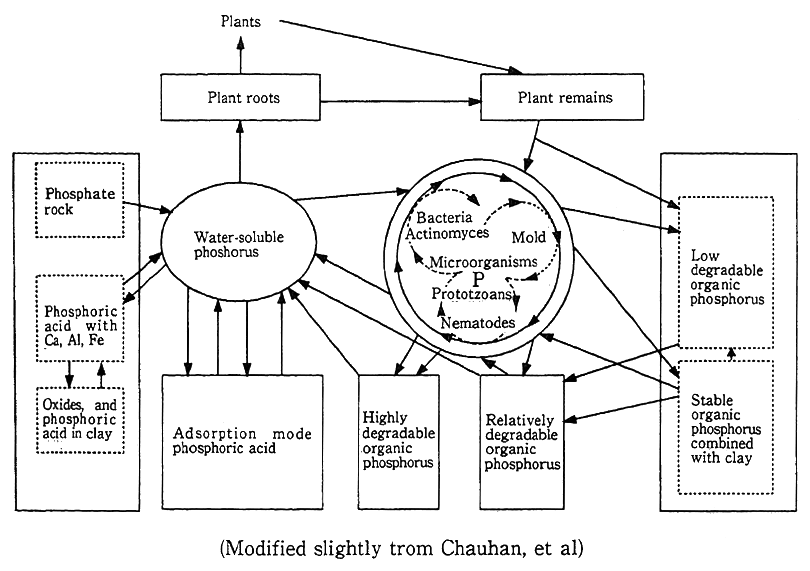
Source : "Kikan Kagaku-sosetsu, 4" (Quaterly Chemistry 4), Science Society of Japan, ed., "Chemisory of Soil"
(2) Burdens on the soil
1) Loss of topsoil
The soil is assumed to retain its overall stock in the recurring rhythm of creation and loss. Nevertheless, the soil loss now occurring surpasses the speed at which soil is created, and has become a problem. Soil loss means the basic loss of the various environmental protection functions possessed by the soil. Let's first look at the mechanism for how this occurs.
Soil loss occurs as the result of water or wind action. This water or wind action, which either washes away the soil or scatters it on the wind, is called soil erosion. The soil erosion by water generally occurs because of rainfall. Because Japan has many sloped areas and is often subject to heavy rains, it is particularly susceptible to water erosion. The rate of water erosion can be influenced by both natural factors and artificial factors. Erosion volume is determined by climatic, topo-graphic, vegetation, soil, and artificial factors. The rate of wind-induced soil erosion is affected by wind strength, the extent of soil dryness, and degree of wind and erosion resistance.
While Japan has many sloped areas, the paddies prevent topsoil from washing away and store up nutrients in water. With concentration of population and the aging of mountain farming villages, it is important to beware of the possibility of paddy and forest conservation manage-ment conducted in mountain farming villages becoming slack, and to work to prevent the degradation of soil retention and water nutrient capabilities.
Okinawa and other southwestern islands are covered with the so-called red clay. The construction of summer houses, leisure facilities, roads, and other infrastructure since 1972 has brought into close focus the problem of rapid erosion and washing away of this red clay. The loss of the red clay is becoming a social problem, bringing with it worsening foundations of agricultural production on land and boosting the dangers of flooding and landsliding, while in marine areas it brings bad effects on the coral reefs, seaweed, and mangrove forests (a general designation for clumps of salt-resistant plants distributed in tidal zones along coastlines and river mouth districts of tropical and subtropical regions). We shall look at responses to this problem later.
Table 3-1-3 shows the rate of erosion in the world and in Japan (total erosion volume per year). According to the table, the average rate of erosion in Japan's mountain districts is 500 m3/km2-yaer, while that for forests is 5-100 m3/km2-yaer
Advancing soil erosion causes the loss of fertile soil (topsoil) and farming cannot succeed. In the worst case, it can not only affect the agriculture of a country, but can also affect the socioeconomics of countries that import from that country. Valid ways to prevent water erosion include moderating the slope on dry fields, terracing, cultivating cover crops, following contour lines, and creating grassy zones, while valid ways to prevent wind erosion including planting windbreak trees or setting up windbreak nets, or leaving straw and stubble as obstacles. It is hoped that promotion of these policies will help efforts in prevent-ing soil erosion.
Table 3-1-3 Soil Erosion Speeds
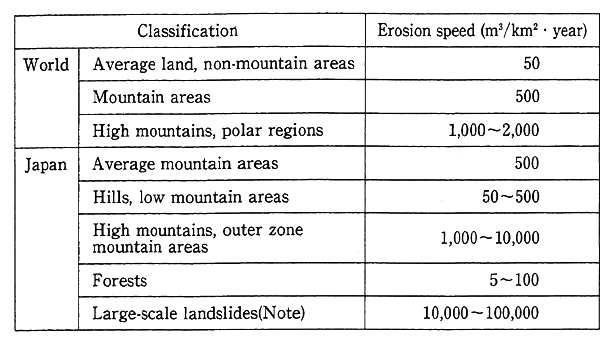
Note : Landslides caused by once-in-a-century rains
Reference: Hiroshi Kadomura and Hiroshi Yamamoto, "Accelerating Erosion Accompanying Land change-speed of Erosion with the Example of Northern Okinawa Prefecture-", Geology Magazine 87 (1978)
Expansion of land use in line with urban development carries with it great effects on all parts of natural land. Depending on the scale and pattern of the urban development, those effects generally tend to appear in the order of vegetation, soil, terrain, and geology. First of all, the trees are removed to make the land a vacant space, then the soil is stripped away or buried, or perhaps covered over with concrete or asphalt. If it is sloped land, the ground surface forms are shaped. Furthermore, for large-scale urban development, it is necessary to flatten the land out, and in locations where there are large extrusions such as hills, large-scale land reformation is conducted whereby every-thing above a few meters is cut off and leveled out, carrying the effects to the geology, the terrain's very foundations.
Fig. 3-1-7 Relationship betwees Cities, Greenery, and Soil
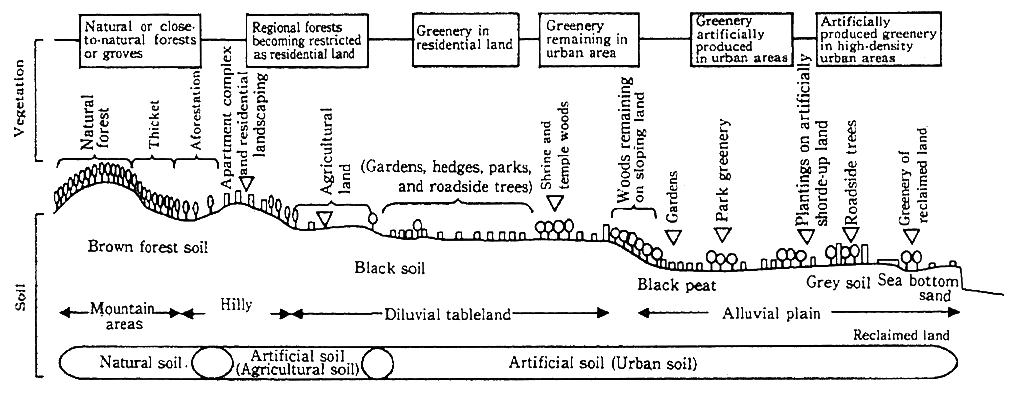
Reference: Takeshi Matsui and Masanori Okazaki, Pedology" - Pedology for Human's Environment
The total annual soil moved in terrain reformation in the 20 years from 1960, extending over a wide area but within the excluded volume (earth and sand movement rate) in a region's total area, is said to have been (1-2) x 102m3/km2-yaer This value is several tens and even a hundred and several tens times the average denudation rate for marshy and hilly regions under natural conditions.
2) Soil pollution caused by industrial activity
i. Special characteristics of soil pollution
When the soil is polluted, the various capabilities it possesses are damaged. First of all, let's look at the special characteristics of soil pollution.
Toxic substances that are the causes of soil pollution can directly seep into the soil by leakage of raw materials or burial of wastes, or in many cases secondary burdens can be placed on the soil due to business activity that results in water pollution or air pollution. Since soil make-up is more complex than water or air and can react in various ways to toxic substances, the mode of soil pollution when compared to water pollution or air pollution has the following characteristics.
(1) If toxic substances burden the soil beyond a certain purifying capability, the substances accumulate and polluted conditions persist over long periods (cumulative pollution). For this reason, merely reform-ing the emissions of the causal substance is not sufficient, and as long as some sort of policies to remove, detoxify, and seal off the polluted substances are not taken, the polluted conditions will not be improved.
(2) The effects of soil pollution directly appear in plant cultivation and in soil organism propagation, and indirectly appear in human health mainly through pollution of water, air, and food products.
(3) While pollution effects are relatively wide-ranging over agricul-tural land, they are generally very localized, and exhibit diverse modes for each site.
Table 3-1-4 Estimates of Expanding Urban Land Use and of Agricultural Land Shaping in Japan's National Land Development (Averages for 1970-1972)
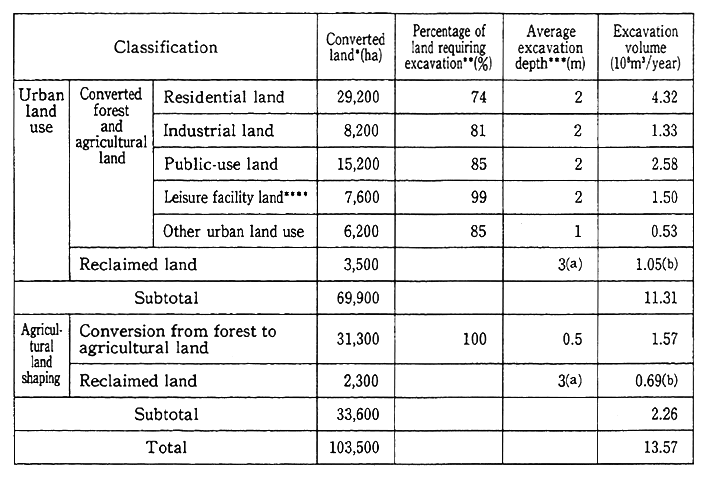
* : Average annual conversion of land in 1970-72 (National Land Agency, 1977)
** : Estimated from ratio of terrain classification of land use conversion projects for 1965-75 (National Land Agency, 1977)
*** : Assumed excavation depth for land requiring excavation
**** : Mostly for golf courses
(a) Assuming shored-up land is a standard 3 meters
(b) Sand dredged for reclaimed land use
Reference Hiroshi Kadomura and Hiroshi Yamamoto, "Accelerating Eroion Ac- companying Land change-speed of Erosion with the Example of Northern Okinawa Prefecture", Geology Magazine 87(1978)
(4) Water and air have the property of being considered public assets, but most soil is configured as land held as private assets.
ii. Soil pollution on agricultural land
Let's look at soil pollution of agricultural land as an example of obstruction of food production capabilities. Much of Japan's agricul-tural land is used in paddy form. Since paddies let water stand for long period, it is easy in areas where waste water from mines exist for heavy metals to accumulate in the soil. As a result, examples have been found in Japan of paddy pollution problems due to heavy metals. The pollution sources are mines or businesses that emit toxic substances, and can often be spread over relatively wide areas that correspond to the waste water or soot and smoke emissions. And since the medium of transmis-sion is water or air, the pollution level is spread relatively evenly. The mechanisms for the pollution can be waste water containing toxic substances that is washed out from mines or some other pollution source goes through rivers and agricultural-use water to flow onto agricultural land and have toxic substances accumulate in the soil, or can be soot and smoke that is transmitted through the air to fall on agricultural land and have toxic substances accumulate in the soil.
Representative examples include cadmium pollution in Toyama refecture's Zintsu River drainage area, copper pollution in Gunma Prefecture's Watarase River drainage area, and arsenic pollution in Miyazaki Prefecture's Toroku area. Damage caused by these sub-stances included stunted growth of farm crops and damage to people's health from ingesting agricultural products containing toxic substances. Soil pollution countermeasures technology now in use include unpollut-ed soils brought in and mixed with the soil, polluted soil removed and replaced by other soil brought in, and turning the soil over.
iii. Soil pollution in urban areas
In recent years, monitoring of underground water and other resources has exposed an increasingly large number of cases of soil pollution at abandoned plant sites or on the sites of offices that handle toxic substances. Many of the causes of pollution include leakage associated with damaged manufacturing facilities, inappropriate han-dling of pollutant source substances, and inappropriate burial of wastes on plant sites before the implementation of the Wastes Disposal Law. Although the pollution is highly localized, there are also cases where the polluted soil can affect the surrounding environment, such as under-ground water. The pollution mechanisms include waste water from plants or businesses handling toxic substances (seeping into under-ground water), leakage due to damaged facilities, and burial of wastes, which causes toxic substances to accumulate in the soil. Furthermore, the toxic substances can also be washed out of the polluted soil to cause water pollution. Pollutants include cadmium, hexavalent chromium, arsenic, lead, mercury, cyanide, PCBs, and organochlorine compounds (such as trichloroethylene). Often, the effect on the environment is in the form of toxic substances leaching out of polluted soil and causing the pollution of underground water and public water areas. If we look at the state of pollution occurrences and of the countermeasures taken, pollu-tion due to such substances as heavy metals or PCBs often becomes manifest in the course of reforming land for reutilization of plants or research facilities, while in recent years cases of soil and underground water pollution due to such substances as trichioroethylene have also begun to appear (see Chapter 5, Section 3). Countermeasure technologies for soil and underground water pollution include removal of pollutants, prevention of pollutant leaching, and control of underground water flows.
3) Agriculture and soil fertility
Our activities can also affect the production capabilities of plants that the soil took many long years to make possible. Soil fertility (productive capacity of farmland derived from soil properties) is believed to be supported by rational cycles of organic and inorganic materials. The organic materials cycle involves organic materials com-posed out of solar energy, carbonic gases, water, and inorganic nutrients and then being decomposed by microorganisms in the topsoil layer. It then remains in the soil as carbonic gases, water, inorganic nutrients, and humus. The inorganic material cycle involves inorganic nutrients, which have been slowly released into the soil from rocks due to the weathering process, being absorbed by plants and then eventually retur-ned to the soil as life form remains and accumulated in the topsoil layer. This rational cyclic accumulation of organic and inorganic materials into the topsoil provides strength for the production of the next genera-tion of plants.
In cold climates, fallen leaves do not decompose and a thick layer of humus forms, and the acidified soil formed from the humus acid has difficulty in forming luxuriant plant communities. And in tropical regions, decomposition of organic materials is very fast, so that should forests be removed all at once, the organic materials in the soil are swiftly decomposed and nutrients suddenly leached out, leading to a decline in soil fertility (Figure 3-1-8).
Japan is said to be able to maintain rich soil fertility because of the moist, moderate climate. Nevertheless, it is feared that disruption of the organic and inorganic material cycles through excess cultivation or introduction of unnecessarily large amounts of chemical fertilizers can destroy the soil habitat, leading to a decline in soil fertility. It is believed that restoration of soil fertility is difficult, and a return to fields using livestock manure may be the most effective way to maintain rational organic and inorganic material cycles. Moreover, Japan is faced with such social situations as the declining and aging of agricultural labor, and the declining farming link with livestock, and maintaining soil fertility may become more difficult. Future policies will probably have to take these viewpoints into account.
Fig. 3-1-8 Consumption and Accumulation of Organic Substances in Soil After Lumbering in Tropical Forest
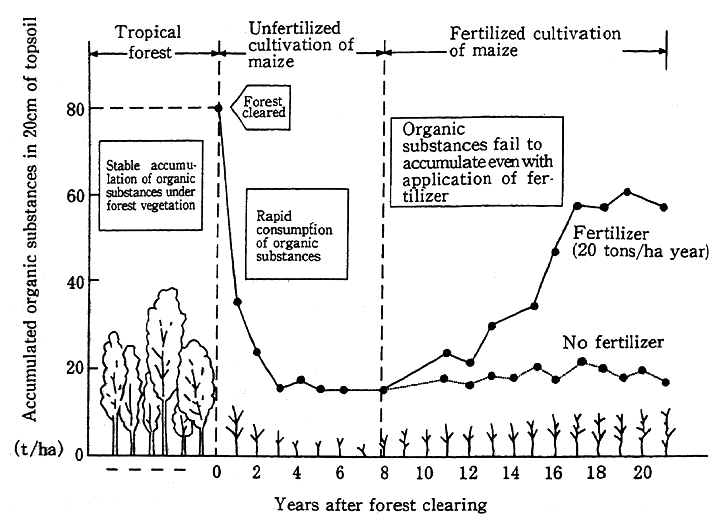
Source: Hiroshi Fujimaki, Kyoko Sajo, and Shigeru Kimura, eds., "Q & A Rich Japan's Biological Environmental Resources"